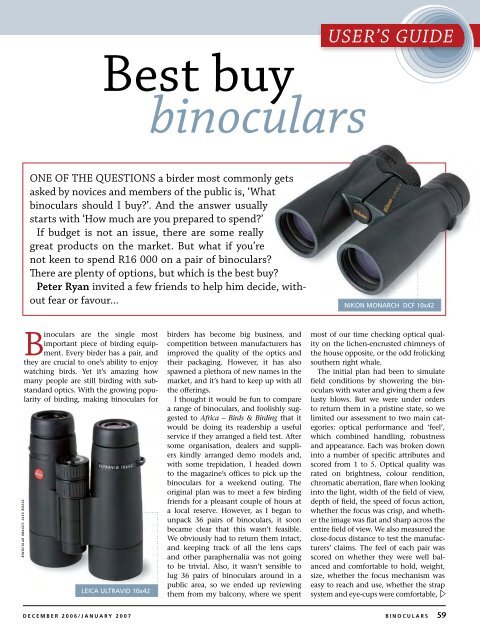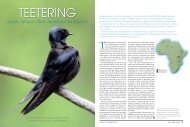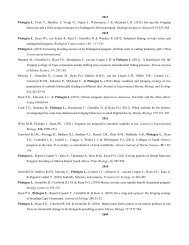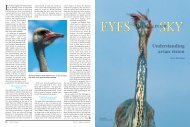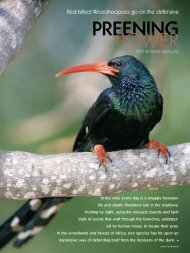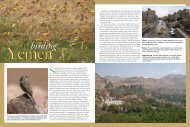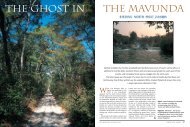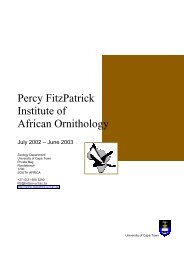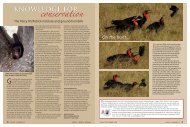binoculars - Africa Geographic
binoculars - Africa Geographic
binoculars - Africa Geographic
You also want an ePaper? Increase the reach of your titles
YUMPU automatically turns print PDFs into web optimized ePapers that Google loves.
Best buy<br />
<strong>binoculars</strong><br />
User’s guide<br />
One of the questions a birder most commonly gets<br />
asked by novices and members of the public is, ‘What<br />
<strong>binoculars</strong> should I buy’. And the answer usually<br />
starts with ‘How much are you prepared to spend’<br />
If budget is not an issue, there are some really<br />
great products on the market. But what if you’re<br />
not keen to spend R16 000 on a pair of <strong>binoculars</strong><br />
There are plenty of options, but which is the best buy<br />
Peter Ryan invited a few friends to help him decide, without<br />
fear or favour...<br />
NIKON MONARCH DCF 10x42<br />
Binoculars are the single most<br />
important piece of birding equipment.<br />
Every birder has a pair, and<br />
they are crucial to one’s ability to enjoy<br />
watching birds. Yet it’s amazing how<br />
many people are still birding with substandard<br />
optics. With the growing popularity<br />
of birding, making <strong>binoculars</strong> for<br />
binocular images: alex bozas<br />
LEICA ULTRAVID 10x42<br />
birders has become big business, and<br />
competition between manufacturers has<br />
improved the quality of the optics and<br />
their packaging. However, it has also<br />
spawned a plethora of new names in the<br />
market, and it’s hard to keep up with all<br />
the offerings.<br />
I thought it would be fun to compare<br />
a range of <strong>binoculars</strong>, and foolishly suggested<br />
to <strong>Africa</strong> – Birds & Birding that it<br />
would be doing its readership a useful<br />
service if they arranged a field test. After<br />
some organisation, dealers and suppliers<br />
kindly arranged demo models and,<br />
with some trepidation, I headed down<br />
to the magazine’s offices to pick up the<br />
<strong>binoculars</strong> for a weekend outing. The<br />
original plan was to meet a few birding<br />
friends for a pleasant couple of hours at<br />
a local reserve. However, as I began to<br />
unpack 36 pairs of <strong>binoculars</strong>, it soon<br />
became clear that this wasn’t feasible.<br />
We obviously had to return them intact,<br />
and keeping track of all the lens caps<br />
and other paraphernalia was not going<br />
to be trivial. Also, it wasn’t sensible to<br />
lug 36 pairs of <strong>binoculars</strong> around in a<br />
public area, so we ended up reviewing<br />
them from my balcony, where we spent<br />
most of our time checking optical quality<br />
on the lichen-encrusted chimneys of<br />
the house opposite, or the odd frolicking<br />
southern right whale.<br />
The initial plan had been to simulate<br />
field conditions by showering the <strong>binoculars</strong><br />
with water and giving them a few<br />
lusty blows. But we were under orders<br />
to return them in a pristine state, so we<br />
limited our assessment to two main categories:<br />
optical performance and ‘feel’,<br />
which combined handling, robustness<br />
and appearance. Each was broken down<br />
into a number of specific attributes and<br />
scored from 1 to 5. Optical quality was<br />
rated on brightness, colour rendition,<br />
chromatic aberration, flare when looking<br />
into the light, width of the field of view,<br />
depth of field, the speed of focus action,<br />
whether the focus was crisp, and whether<br />
the image was flat and sharp across the<br />
entire field of view. We also measured the<br />
close-focus distance to test the manufacturers’<br />
claims. The feel of each pair was<br />
scored on whether they were well balanced<br />
and comfortable to hold, weight,<br />
size, whether the focus mechanism was<br />
easy to reach and use, whether the strap<br />
system and eye-cups were comfortable, <br />
december 2006/january 2007<br />
<strong>binoculars</strong><br />
59
user’s guide to <strong>binoculars</strong><br />
© canon<br />
whether they were suitable for use with<br />
glasses, aesthetically pleasing and on<br />
their apparent robustness. We also noted<br />
whether the manufacturer claimed they<br />
were waterproof, but didn’t put this to<br />
the test. Finally, we checked for useful<br />
accessories, such as a rain-guard.<br />
Before the rest of the panel arrived,<br />
I prepared a batch of assessment forms<br />
and set out all the <strong>binoculars</strong>. (It’s easy<br />
to see why <strong>binoculars</strong> arrive with their<br />
straps neatly folded away – it’s too labour<br />
intensive to fit them! Why do many<br />
manufacturers make it almost impossible<br />
to fit the straps through the lugs<br />
on the body of the bins) After more<br />
CANON IS 12x36<br />
than an hour of fiddling, the <strong>binoculars</strong><br />
were ready for testing. Once the panel<br />
got down to work, there ensued eight<br />
hours of concentrated assessment, as<br />
we tried each pair to get an idea of the<br />
range of products on offer, then did it all<br />
over again to do the actual scoring. At<br />
the time, we didn’t know the prices of<br />
the various products (other than having<br />
a rough notion for the top end of the<br />
range). All the scores were then combined<br />
and each pair of <strong>binoculars</strong> was<br />
given a 1- to 5-star rating for optics and<br />
feel. The sum of these ratings was then<br />
divided by the cost (using an arcane<br />
transformation) to come up with an<br />
index of value for money. The results are<br />
summarised in the table on page 62.<br />
The Cheapies<br />
Of the 36 pairs reviewed, 26 cost more<br />
than R1 500. The remaining 10 were<br />
either porro-prism (big, clunky <strong>binoculars</strong>)<br />
or small, compact bins designed<br />
for slipping into your pocket or taking<br />
on a hike when weight is a serious issue.<br />
The porro-prisms didn’t rate too badly<br />
for optics, but for the most part fared<br />
poorly in terms of feel and robustness.<br />
Almost all have external focusing (the<br />
eyepieces move in and out to focus),<br />
which pretty much precludes them being<br />
waterproof, and from experience we<br />
have found that they are easily knocked<br />
out of alignment. The one exception<br />
is the Leupold Yosemite 6x30, which<br />
has internal focusing and is claimed to<br />
be fully waterproof. It is small, compact<br />
and as cute as one can imagine<br />
a pair of porro-prism bins getting, but<br />
its relatively low magnification is probably<br />
insufficient for most birders.<br />
Some of the compact <strong>binoculars</strong> were<br />
quite reasonable, but their field of view<br />
tends to be limited. If you are shopping<br />
in this price range, we’d consider<br />
the Canon 8x23 compacts, which are<br />
claimed to be waterproof and look more<br />
robust than most. Unfortunately, we<br />
didn’t get to test the Canon 8x32 WP<br />
which looks like an even better entrylevel<br />
option. If you are considering a pair<br />
of porro-prism <strong>binoculars</strong>, the Nikon<br />
Action 8x40 is reasonably priced and<br />
has a tolerable close-focus distance. All<br />
the others are pretty hopeless, not even<br />
focusing on birds five metres away.<br />
Roof-prisms rule<br />
Only one pair of <strong>binoculars</strong> costing more<br />
than R1 500 weren’t the vastly superior<br />
try before you buy If you are considering buying a pair of <strong>binoculars</strong>, check the following points.<br />
3 How do they feel when you hold them Are they nicely balanced<br />
and not too heavy<br />
3 Is the focus wheel accessible and easy to use<br />
3 Can the adjustable eyepiece be locked to suit your eyes<br />
3 How do the eye-cups feel Can they be locked at a level that suits<br />
your eyes<br />
3 Is the close-focus distance three metres or less<br />
3 How fast is the focus (It shouldn’t take more than 0.7 rotations<br />
of the focus wheel to go from five metres to infinity.)<br />
3 Is the field of view adequate (As a general rule of thumb, avoid<br />
anything where the objective diameter divided by the magnification<br />
is three or less.)<br />
3 Is the image nice and bright Are the colours true to life<br />
3 Is there excessive chromatic aberration (Look for ghostly blue<br />
or yellow edges to objects when viewed towards the edge of the<br />
field of view.)<br />
LEUPOLD YOSEMITE 6x30<br />
3 Is the focus sharp across the field of view, or does it get soft<br />
towards the edges<br />
3 Is the image flat (Try panning quickly and look for bulging in<br />
the central portion of the image.)<br />
3 Is there a problem with flare Ask to take the <strong>binoculars</strong> outside<br />
and look towards the sun (but not at it, as that can seriously<br />
damage your eyes!). Does the image get washed out by ghostly<br />
internal reflections<br />
3 Are they robust<br />
3 Are they waterproof Is there any guarantee if they leak Having<br />
nitrogen-filled <strong>binoculars</strong> ensures they are sealed, and prevents<br />
internal fogging or problems with fungal growth on the lenses.<br />
3 Is there a rain-guard that you can leave attached to one of your<br />
neck straps<br />
3 Are there objective covers, should you want them<br />
3 Is the strap comfortable (Bear in mind that this can be replaced.)<br />
roof-prism design. In addition to their<br />
more compact and comfortable shape,<br />
roof-prisms allow for greater robustness,<br />
fully internal focusing and true waterproofing<br />
(but beware – not all roofprisms<br />
are truly waterproof!). If you<br />
can afford it, we strongly recommend<br />
investing the extra money and buying<br />
a pair with roof-prisms. The only pair<br />
of porro-prism bins in this price range<br />
was the Pentax XCF 10x50, which is<br />
claimed to be waterproof, but is very<br />
large, heavy and awkward to use, and<br />
has the bizarre feature of a focus lock.<br />
No one could imagine why this would<br />
be useful to a birder.<br />
Hopefully we’ve convinced you that<br />
roof-prism is the way to go. But now the<br />
field gets more crowded. We were faced<br />
with 25 pairs of <strong>binoculars</strong>, ranging in<br />
price from just over R1 600 to R19 000.<br />
The field here can be divided into three<br />
price brackets: the top end (R15 000 and<br />
up), mid-range (R7 000–R13 000), and<br />
bargain basement (less than R5 000).<br />
ZEISS victory fl 10x42<br />
The top end: R15 000–R19 000<br />
If money is no object, then you’re probably<br />
going to opt for one of the three big<br />
names: Leica’s Ultravid, Swarovski’s EL or<br />
Zeiss’s Victory FL range. All three lived<br />
up to their big-ticket reputations, with<br />
their flagship 10x42 models scoring maximum<br />
marks for optical quality. We were<br />
hard pressed to separate them, with Zeiss<br />
shading the others slightly in twilight<br />
conditions and having a better closefocus<br />
distance. Its main drawback<br />
was its rather large size, which<br />
felt a little clumsy compared<br />
to the competition.<br />
Only Zeiss submitted<br />
a smaller model for<br />
evaluation, the 10x32.<br />
This was equally good<br />
optically, except in twilight<br />
conditions, when<br />
it couldn’t compete with<br />
the larger objective models. However, it<br />
is much smaller and lighter, and would<br />
certainly appeal to the less-macho birder<br />
(or one over-burdened with other gear).<br />
The most expensive model assessed was<br />
Leica’s Duovid, a novel design that offers<br />
8x or 12x magnification by twisting<br />
each eyepiece in turn. It was optically<br />
impressive, apart from a rather mediocre<br />
close-focus distance, but we all felt the<br />
marked increase in weight wasn’t worth<br />
the extra magnification. Rather have a<br />
pair of 10x bins and a ’scope.<br />
Mid-range: R7 000–R13 000<br />
This sector covers a wide range in price,<br />
and comprises such a mixed bag that<br />
it is hard to generalise. Most are conventional<br />
roof-prism <strong>binoculars</strong>, which<br />
fall between two stools to some extent,<br />
being not quite up with the quality<br />
of the top end and not offering much<br />
more than some of the cheaper roofprism<br />
models. Zeiss’s Conquest range<br />
is pretty similar to the top-end Victory<br />
models, but uses a lower quality glass.<br />
The difference is not great until viewing<br />
conditions become challenging (at<br />
dusk or when looking towards the sun).<br />
The 10x40 model is pretty good, but we<br />
all felt the 10x50 was just too large and<br />
heavy to have to carry around all day.<br />
An annoying feature was the lack of a<br />
rain-guard; although you can order one<br />
as an accessory, it seems a pity not to<br />
provide one with what is, after all, still a<br />
pretty expensive pair of <strong>binoculars</strong>.<br />
The other <strong>binoculars</strong> in this price<br />
bracket are the flagship offerings by<br />
a number of other manufacturers.<br />
Leupold’s Gold Ring 10x32 is remarkable<br />
for focusing down to just more<br />
than a metre, although you may start to<br />
feel a little queasy at this range. We all<br />
commented on the uncomfortably large<br />
eye-cups, which might be required when<br />
focusing so close, but they really detract<br />
from the bins’ appeal for everyday use.<br />
SWAROVSKI EL 10x42<br />
Nikon’s HG 10x42 and Bushnell’s Elite<br />
8x43 are more conventional models that<br />
use the best-quality glass in an attempt<br />
to challenge the top-end marques. Both<br />
are nice <strong>binoculars</strong>, but are not quite up<br />
to the standards of the big three. Of the<br />
two, the Bushnell offers better value for<br />
money, and comes with objective covers,<br />
as well as a nifty semi-rigid case.<br />
Perhaps the most distinctive pair of<br />
bins we tested was the Canon Image<br />
Stabilised (IS) 12x36. Canon has had<br />
great success with its IS camera lenses,<br />
and apparently sees IS as the wave of<br />
the future for <strong>binoculars</strong> too, but these<br />
will need further development if they<br />
are going to have a large impact on<br />
the birding market. Available in 12x,<br />
15x and 18x models, the floating lens<br />
system cuts out minor shakes as soon<br />
as you press the centrally-mounted IS<br />
button. But the design takes some getting<br />
used to, with the IS button displacing<br />
the focus wheel from the most<br />
accessible position. The field of view is<br />
a little narrow, the close focus distance<br />
is more than seven metres, and we<br />
had concerns about its ability to withstand<br />
arduous field conditions. And it<br />
is rather unusual to have to carry spare<br />
batteries for your <strong>binoculars</strong>!<br />
Bargain basement: less than R5 000<br />
Rather like the car market, the field gets<br />
crowded at the lower end, with lots<br />
of competitively priced products. It is<br />
this sector that has seen the greatest<br />
growth, thanks to the increase in the<br />
global demand for birding <strong>binoculars</strong>,<br />
and there are some real bargains to be<br />
had. If you’re still birding with a pair<br />
of porro-prism <strong>binoculars</strong> that you <br />
60 <strong>binoculars</strong> africa – birds & birding<br />
december 2006/january 2007<br />
<strong>binoculars</strong> 61
user’s guide to <strong>binoculars</strong><br />
MODEL OPTICS FEEL VALUE COST (R)* MASS (g) TYPE<br />
CLOSEST<br />
FOCUS (m)<br />
Water-<br />
PROOF<br />
RAIN-<br />
Guard<br />
Leica Duovid 8-12x42 HHHHI HHHI HH 19 000 1 110 R 3.0/3.2 Y Y Y<br />
Swarovski EL 10x42 HHHHH HHHHI HHI 17 700 910 R 2.6 Y Y Y<br />
Leica Ultravid 10x42 HHHHH HHHHI HHI 16 500 850 R 3.0 Y Y Y<br />
Zeiss Victory FL 10x42 HHHHH HHHH HHI 16 035 860 R 2.2 Y Y Y<br />
Leica Ultravid 8x42 HHHHH HHHHI HHI 16 000 860 R 2.8 Y Y Y<br />
Zeiss Victory FL 10x32 HHHHI HHHHH HHI 14 995 630 R 2.0 Y Y Y<br />
Nikon L – HG Series 10x42 HHHH HHHH HH 13 000 860 R 3.0 Y Y N<br />
Leupold Golden Ring 10x32 HHHH HHHI HH 10 995 850 R 1.1 Y Y N<br />
Zeiss Conquest B 10x50 HHHHI HHHI HH 10 600 980 R 3.6 Y Y N<br />
Zeiss Conquest B 10x40 HHHHI HHHH HHI 9 280 860 R 2.8 Y Y N<br />
Bushnell Elite 8x43 HHHHI HHHH HHH 7 182 740 R 2.5 Y Y Y<br />
Canon Image Stabilised 12x36 HHHI HH HI 7 000 750 IS 7.2 N N N<br />
Leupold Pinnacles 8x42 HHHH HHHHI HHHI 5 100 740 R 1.9 Y Y N<br />
Leupold Cascades 10x42 HHHH HHHHI HHHH 3 995 710 R 2.8 Y Y N<br />
Leupold Olympic 8x42 HHHH HHHHH HHHH 3 950 675 R 2.3 Y Y N<br />
Leupold Katmai 6x32 HHHI HHHHI HHHI 3 895 590 R 1.4 Y Y N<br />
Pentax DCF HRII 8x42 HHHH HHHH HHHH 3 200 860 R 3.8 Y N N<br />
Nikon Monarch DCF 10x42 HHHH HHHHI HHHHH 3 000 695 R 2.2 Y Y N<br />
Bushnell Legend 8x42 HHHH HHHH HHHHI 2 736 895 R 2.2 Y Y N<br />
Bushnell Legend 8x32 HHHHI HHHH HHHHH 2 394 730 R 2.3 Y N N<br />
Vixen Atrek 10x42 HHHI HHHH HHHHI 2 195 800 R 1.3 Y Y N<br />
Pentax DCF HS 8x36 HHHHI HHHH HHHH 2 000 715 R 2.8 splash Y N<br />
UltraOptec Game-Pro 8x42 HHHH HHHI HHHHH 1 993 815 R 1.2 Y Y N<br />
Pentax PCF WPII 10x50 HHH HH H 1 850 1 080 PR 5.3 Y N N<br />
Bushnell Nature View 10x42 HHHH HHHH HHHHH 1 710 795 R 3.4 Y Y N<br />
CPC Moonraker 10x42 HHHI HHHH HHHHH 1 595 720 R 2.6 Y Y Y<br />
Canon AWP 8x23 HHH HHHH HHHH 1 300 420 COM 2.6 Y N N<br />
Leupold Yosemite 6x30 HHHI HHH HHHI 1 200 555 PR 3.7 Y Y N<br />
Bushnell Excursion 10x28 HHH HHHH HHHHH 1 140 540 R 3.1 Y Y Y<br />
Pentax XCF 10x50 HHH HH HHH 1 000 920 PR 8.2 N N N<br />
Nikon Travelite 9x25 HH HHHH HHH 1 000 280 COM 2.5 N N N<br />
Nikon Action CF 8x40 HHH HH HHHH 849 815 PR 3.5 N Y N<br />
Nikon Sport Lite 10x25 HH HHHH HHH 700 290 COM 2.8 N N N<br />
Bushnell Nature View Birder 8x40 HHH HH HHH 570 590 PR 6.3 N N N<br />
UltraOptec Series 2 8x40 HH HH HHH 455 740 PR 5.3 N N N<br />
UltraOptec Bak 4 Prism 8x21 H HHH HHH 227 195 COM 3.5 N N N<br />
PR – Porro-prism<br />
R – Roof-prism<br />
COM – Compact<br />
OBJ<br />
COVER<br />
*The prices shown in this table were correct as at the end of September 2006 – they are intended as<br />
a guide only and we cannot take into account import currency fluctuations and retail price increases.<br />
BUSHNELL ELITE 8x43<br />
bought 10 or 15 years ago because you<br />
think you can’t afford to upgrade, do<br />
yourself a favour and try out some of<br />
these bins. The difference in quality will<br />
revolutionise your birding experiences.<br />
Leupold has a suite of nice, compact<br />
and light roof-prism models towards the<br />
upper end of this price range (R4 000–<br />
R5 000) that are well worth a look. Our<br />
favourite was the 8x42 Olympic; we<br />
were put off the 10x42 Cascades model<br />
because it came in a camouflage finish,<br />
probably aimed at the US deer-hunting<br />
brigade but potentially dangerous in<br />
many parts of <strong>Africa</strong>, where you could be<br />
mistaken for a mercenary or spy! If you<br />
can get a pair with a more traditional<br />
finish, they will be worth considering.<br />
peter ryan<br />
Pentax supplied us with two DCF models,<br />
the HRII 8x42 and the HS 8x36. Both<br />
were quite acceptable, although the latter<br />
is specifically rated as splash-proof<br />
rather than waterproof. Bushnell<br />
has plenty to offer, with the<br />
Legend series offering robust<br />
if rather heavy <strong>binoculars</strong> in<br />
the R2 000–R3 000 range, and<br />
the Nature View 10x42 offering<br />
exceptional value for money at less<br />
than R2 000. Nikon’s Monarch 10x42<br />
and 8x42 models also offer great value<br />
in the R2 000–R3 000 range, and are<br />
lighter, with more modern styling than<br />
Bushnell’s Legend series. The Vixen Atrek<br />
10x42 and CPC Moonraker 10x42 were<br />
both rated a little lower than their opposition<br />
in terms of their optics, largely as<br />
a result of more noticeable chromatic<br />
aberration. However, they too offer the<br />
buyer good value for money.<br />
Finally, the surprise package was the<br />
UltraOptec Game-Pro 8x42, which was<br />
optically quite acceptable for a brand<br />
that is not that well known. It has exceptionally<br />
close focus (1.3 metres) and<br />
would be ideal for butterfly or dragonfly<br />
enthusiasts. It was let down a bit by its<br />
finishing touches, but this may be a<br />
brand to watch in future.<br />
Rating <strong>binoculars</strong>, like beauty, is a less<br />
than exact science. Before buying, be<br />
sure to check the product yourself (see<br />
the checklist). Each person has their own<br />
preferences, particularly when it comes<br />
to feel. Also, please note that we did not<br />
get to test the full range of <strong>binoculars</strong> that<br />
are on the market, and there are other<br />
contenders, especially in the reasonably<br />
priced bracket, which may well be worth<br />
considering. Happy shopping!<br />
The panel<br />
Despite asking a range of birders to assist,<br />
most had more sense and manufactured<br />
an excuse to be elsewhere. However,<br />
we finally ended up with a nicely balanced<br />
team of four assessors from across the<br />
user spectrum. At the end of the exercise,<br />
each was asked to pick the bins they would<br />
choose to keep from the range on offer.<br />
Cliff Dorse (left) – birder and nature<br />
conservation officer<br />
Current <strong>binoculars</strong>: Swarovski 10x42 (old<br />
model). His choice: Swarovski EL 10x42.<br />
<br />
ULTRAOPTEC GAME-PRO 8x42<br />
PENTAX DCF HS 8x36<br />
Lilly Poulsom – wildlife artist and birder<br />
Current <strong>binoculars</strong>: Nikon EB 9x25.<br />
Her choice: Leupold Olympic 8x42.<br />
Peter Ryan – birder and ornithologist<br />
Current <strong>binoculars</strong>: Swarovski EL 8.5x42 (but often<br />
borrows his wife’s old Leica 8x32). His choice:<br />
Zeiss Victory FL 10x32 (somewhat influenced by<br />
guilt at always stealing his wife’s bins).<br />
Suretha van Rooyen – beginner birder<br />
Current <strong>binoculars</strong>: Bushnell H20 10x42.<br />
Her choice: Swarovski EL 10x42.<br />
62 <strong>binoculars</strong> africa – birds & birding<br />
december 2006/january 2007<br />
<strong>binoculars</strong> 63


